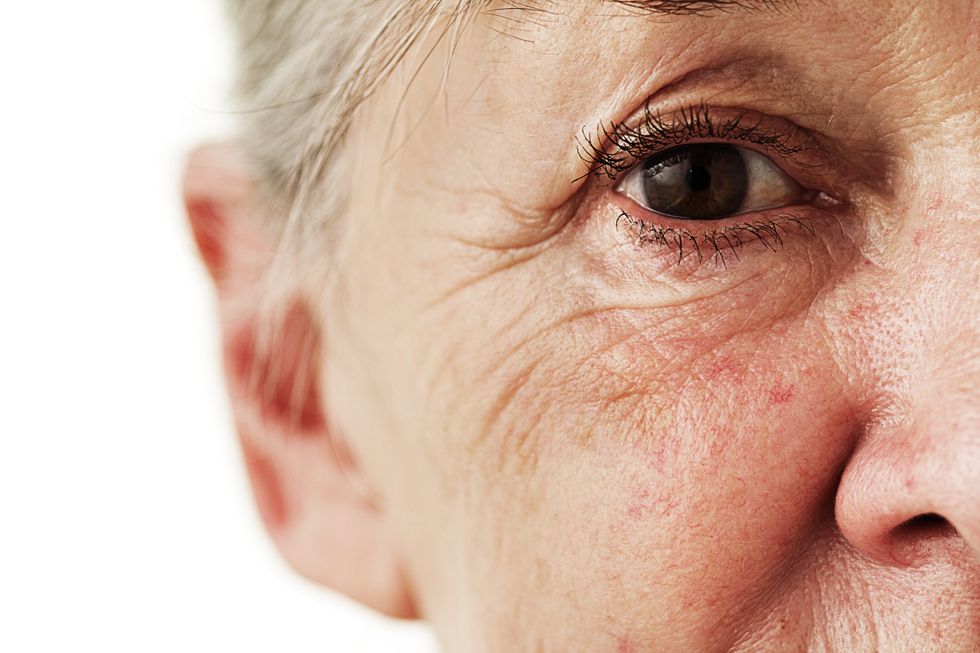Droopy eyelids: The top treatments, preventative measures and make-up techniques to minimise the appearance of sagging skin

Makeup hacks and holistic skin care can reduce the appearance of sunken eyes
|GETTY

GB News reached out to top experts in the beauty industry for their professional tips on lifting the eye area during menopause
Don't Miss
Most Read
Latest
Sagging eyes show up for many reasons, but a hormonal decline during a woman's senior years can speed up changes around the eye area.
The loss of collagen means the eyes slowly start settling back into the eye sockets, and this making the eyes appear sunken over time.
One of the main issues with this area of the face is that the skin is thinner, but with a little help from the right self-care methods - the area is less likely to sink.
GB News reached out to several experts to help whittle down the top preventative methods and treatments.
What causes droopy eyelids?
According to Doctor Adam Weinfeld, a plastic surgeon at Austin Plastic Surgeon, droopy eyelids result from an accumulation of excess and lax skin in the upper and lower eyelids over time.
“This can also occur due to the weakening and sagging of fat compartments and the supporting tissues with ageing," the expert explained.
“Additionally, the descent of eyebrows as tissues in the forehead loosen contributes to droopy eyelids.”
Another cause is ptosis, where the eyelid margin sits lower than normal, often due to the stretching and lengthening of the muscle ligament that raises the eyelid.
Doctor Wendy Engelman, a dermatologist at Shafer Clinic Fifth Avenue, confirmed that ptosis, too, is a common side effect of ageing.

Several conditions can speed up the drooping of the eyelid
|GETTY
“As you get older, the muscles that raise your eyelids weaken, and the skin around your eyes stretches," the expert said.
“Additional causes can include injury to the area, certain diseases like diabetes, nerve damage and even certain medications.”
Can droopy eyelids be reversed?
It is generally accepted that non-surgical procedures are the least effective measures against droopy eyelids, but when asked whether the physical changes could be reversed, Doctor Engelman responded: “Within reason, yes."
Most cases can be tackled with the help of non-invasive treatment - or by surgery with a qualified plastic surgeon, the expert shared.
“You should always speak with a trusted physical about the course of treatment that may be right for you," said Dr Engelman.
“There are in-office treatments, such as EMFACE, which strengthens the muscles in the face, or Lumenis NuEra Tight, which can tighten the skin to prevent droopy eyelids.
“Your doctor may also consider a CO2 laser, such as Fraxel, in the area, which can help with eyelid tightening.”
Doctor Laura Geige, a Psychologist at the Lithuanian University of Health Sciences, argues that the reversibility of droopy eyelids hinges on the severity of the condition and the chosen intervention strategy.
She believes non-surgical modalities encompassing lifestyle adjustments, specialised skin care regimens, and targeted facial exercises can yield notable improvements, particularly in mild to moderate cases.
“Surgical interventions like blepharoplasty offer definitive correction by addressing excess skin and repositioning underlying tissues," noted Dr Geige.
“However, it’s imperative to consult with a qualified practitioner to ascertain the most suitable course of action tailored to individual anatomical nuances and aesthetic aspirations."
The holistic approach to preventing droopy eyelids
According to Dr Geige, the best holistic approaches for dealing with droopy eyelids are diligent sun protection, optimal hydration and adherence to a nutrient-rich diet replete with antioxidants and collagen-promoting nutrients.
“Incorporating targeted facial exercises and lymphatic drainage massages can bolster muscle tone and circulation, attenuating the onset of ptosis," the expert explained.
“Furthermore, harnessing the efficacy of advanced skin care formulations fortified with potent ingredients like retinoids and growth factors can fortify the delicate periorbital skin, fostering resilience against sagging and wrinkling.
“Collaborating with a seasoned aesthetic professional ensures access to an array of modalities ranging from non-invasive modalities such as radiofrequency micro-needling to surgical interventions like ptosis repair, thereby empowering individuals to reclaim youthful, vibrant contours with confidence and assurance.”
LATEST DEVELOPMENTS

Make-up tricks for droopy eyelids
Makeup does wonders for brightening the eyes - but even the smallest faux pas can accentuate the very features you’re trying to conceal.
This is why Tricia Cusden, makeup expert and founder of Look Fabulous Forever, recommends adjusting your routine after 50.
She explained: "Eyes appear hooded when the skin on the eyelid has loosened and drooped over the socket line.
"When our eyes become hooded, we lose the natural crease behind the lid and the brow.
"By making a few small adjustments to the way that you apply your makeup, you can reshape your eyes and make them appear bigger."
Because eyes fade and grow sparse with age, brushing and delineating the area with a pencil will bring definition back to the eye area and lift the area in its entirety.
"Cleverly placed eyeshadow can give the illusion of a wider eye, making you appear fresher and more youthful," the beauty guru said.
To achieve this, Tricia recommended the following steps:
1. Use a light matte shade of eyeshadow all over both eyelids and up towards your brow bone.
2. Then, apply a mid-shade eyeshadow onto the hooded part of the lid, just above where the natural sock line is and with a firm brush create an 'arc' of colour where your socket line would naturally be and then blend it out.
3. Use a dark shade in the outer corners to create a fox eye shape.
4. Add mascara to really make your eyes stand out.










